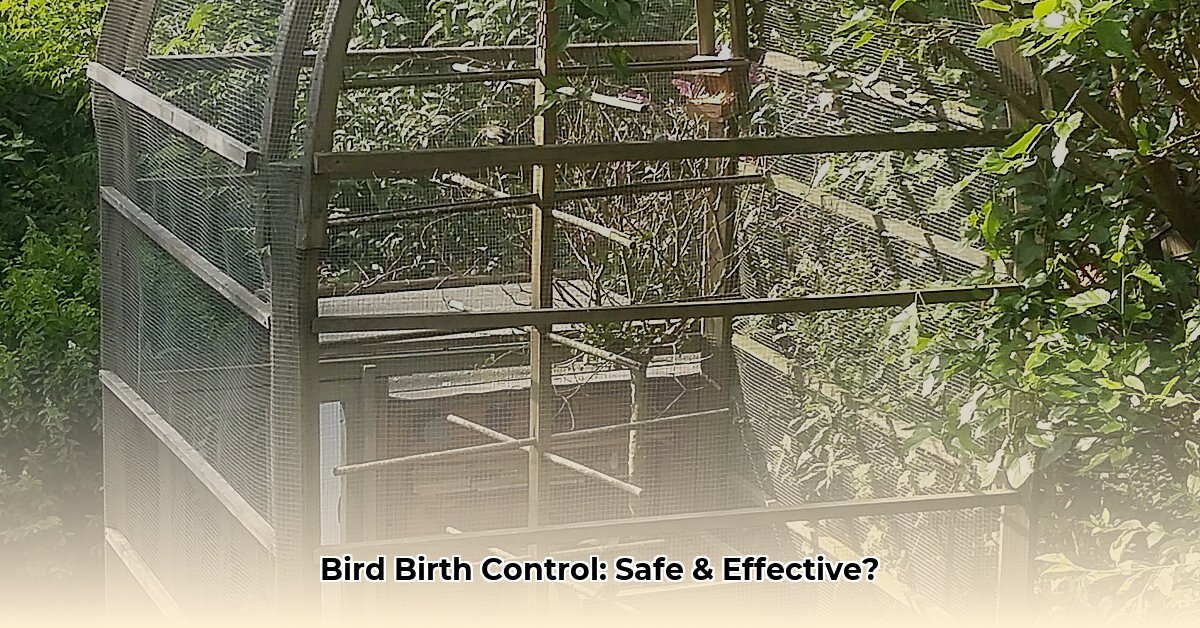Understanding Aviary Contraceptives: From Zoos to Your Plate
“Aviary contraceptive” refers to any substance used to control bird reproduction. These methods are employed in various settings, from managing populations in zoos and wildlife refuges to controlling reproduction in commercial poultry flocks. This article explores the diverse applications of aviary contraceptives, delving into the science, controversies, and ethical considerations surrounding their use, particularly focusing on the chemical Nicarbazin.
Methods for Managing Avian Reproduction
Several techniques are available for controlling bird reproduction, each with its own advantages and disadvantages:
- Hormonal Implants: Similar to human birth control implants, these devices release hormones gradually over time, suppressing reproductive activity. They are typically used in captive birds and pets.
- Injections: Hormonal injections provide a more immediate effect but require repeated administration. This method is suitable for captive birds, particularly in situations requiring rapid reproductive control.
- Dietary Supplements: Certain dietary supplements can influence bird fertility, though their effectiveness varies. While less invasive, this may be less reliable than other strategies.
- Nicarbazin: While primarily used in poultry to combat the parasitic disease coccidiosis, Nicarbazin has a secondary contraceptive effect. This dual action has sparked debate about its presence in the food chain.
Consulting an avian veterinarian is crucial for determining the safest and most effective method for specific bird species and circumstances.
Nicarbazin: A Closer Look at Benefits and Controversies
Nicarbazin, a combination of 4,4′-dinitrocarbanilide (DNC) and 4,6-dimethyl-2-pyrimidinol (HDP), is primarily used to prevent coccidiosis in poultry. However, its contraceptive properties have led to its use in population management for species like Canada geese.
Benefits of Nicarbazin:
- Effective Coccidiosis Control: Nicarbazin effectively combats coccidiosis, a parasitic disease that can severely impact poultry health and productivity.
- Population Management Tool: Nicarbazin offers a non-lethal method for managing bird populations, particularly in situations where other methods are impractical or undesirable.
- Likely Low Risk to Consumers and Predators: Current research suggests minimal risk to humans consuming poultry treated with nicarbazin and to predators of treated birds. However, ongoing monitoring is important.
Controversies Surrounding Nicarbazin:
- Potential Side Effects in Birds: Nicarbazin may cause increased heat stress sensitivity, reduced growth rates, and potential organ damage in birds. Thus, careful monitoring is essential.
- Reduced Egg Production: In laying hens, Nicarbazin can decrease egg production, limiting its use in commercial egg production.
- Presence in the Food Chain: Although regulatory agencies like the FDA consider Nicarbazin residues in poultry safe for human consumption, some groups express concerns about potential long-term health effects.
The Debate Over Nicarbazin in Food
The presence of Nicarbazin residues in poultry meat has fueled debate about its safety for human consumption.
Regulatory agencies like the FDA, EPA, and European Food Safety Authority (EFSA) have conducted extensive research on Nicarbazin. Their findings consistently suggest that the levels found in poultry meat pose a negligible risk to human health. These agencies have established safe residue limits, and routine monitoring ensures these limits are not exceeded.
However, concerns persist, particularly regarding long-term exposure to low doses of Nicarbazin. The Moms Across America report, while highlighting a potential concern, was based on a limited sample size and requires further investigation to determine the prevalence of Nicarbazin residues in commercially available poultry.
Transparency from poultry producers about their use of Nicarbazin would help address public concerns and foster trust. Ongoing research into the long-term effects of low-dose Nicarbazin exposure is also crucial.
Non-Contraceptive Bird Population Management Strategies
Several alternatives to contraceptive methods exist for managing bird populations:
| Method | Description | Pros | Cons |
|---|---|---|---|
| Exclusion | Physical barriers (netting, spikes) prevent birds from accessing specific areas. | Highly effective, targeted approach. | Can be expensive, unsightly, may require specialized installation. |
| Deterrents | Visual or auditory stimuli scare birds away. | Relatively inexpensive, easy to implement. | Effectiveness may be temporary; birds can habituate. |
| Nest Management | Removing eggs or nests to disrupt breeding. | Can reduce local populations. | Labor-intensive, may be ethically concerning, and not a complete population solution. |
| Habitat Modification | Altering the environment to make it less attractive to birds (e.g., removing food sources). | Addresses underlying causes of overpopulation, can be environmentally sound. | Complex, may require extensive planning and resources, potential unintended consequences. |
| Lethal Methods | Trapping or culling birds. | Provides immediate, though temporary, population reduction. | Ethically controversial, may not be sustainable, requires careful regulation and oversight. |
Each method has its own set of ethical considerations. Lethal methods, while sometimes necessary, are generally considered a last resort. Non-lethal methods, while often preferable, require careful planning and implementation to ensure their effectiveness and minimize unintended consequences for the birds and the broader ecosystem.
The Ethical Considerations of Bird Population Control
Managing bird populations raises complex ethical questions. Balancing human needs with bird welfare requires careful consideration of various perspectives.
Key ethical considerations include:
- Respect for Animal Welfare: Minimizing stress and suffering to birds during population control efforts is paramount. Choosing the most humane methods available and employing them responsibly is crucial.
- Environmental Impact: Understanding the potential impact of population control on the broader ecosystem is essential. Unintended consequences, such as disrupting food webs or impacting other species, must be carefully considered.
- Transparency and Public Engagement: Open communication with the public about the methods and rationale behind bird population control fosters understanding and trust. This includes addressing public concerns and incorporating diverse perspectives into decision-making.
- Ongoing Research and Evaluation: Continuously evaluating the effectiveness and ethical implications of bird population control methods is essential. This includes supporting research into new, more humane, and environmentally sustainable approaches.
What You Can Do
You can contribute to responsible bird population management and food safety:
- Educate Yourself: Learn about different bird control methods, their effectiveness, and their ethical implications.
- Support Research: Advocate for research into safer and more sustainable bird population management strategies.
- Choose Wisely: When purchasing poultry, consider supporting producers who prioritize bird welfare and transparently disclose their practices.
- Engage in Dialogue: Participate in conversations about bird population management and food safety to promote informed decision-making.
By staying informed and making conscious choices, we can strive for a more balanced and ethical approach to managing bird populations while ensuring the safety of our food supply.
- How Did Charles F. Brush Discover Wind Energy Tech? - November 19, 2025
- Wind Energy Vertical: Weighing the Pros and Cons of Wind Power - November 16, 2025
- How Much Energy Does a Wind Turbine Actually Create? - November 14, 2025
















